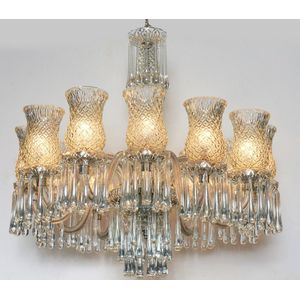Art Deco Venetian Glass Chandelier with Glass Droplets
An impressive Art Deco Venetian glass chandelier, circa 1920s, having twelve branches with moulded pineapple formed shades, all heavily adorned with glass droplets, emanating from a central stem, the chandelier 78 cm long (not including chain)
You must be a subscriber, and be logged in to view price and dealer details.
Subscribe Now to view actual auction price for this item
When you subscribe, you have the option of setting the currency in which to display prices to $Au, $US, $NZ or Stg.
This item has been sold, and the description, image and price are for reference purposes only.
- Art Deco Period - The Art Deco period was a cultural movement that emerged in the 1920s and 1930s, and was characterized by its emphasis on modernism, luxury, and elegance. The name "Art Deco" comes from the Exposition Internationale des Arts Décoratifs et Industriels Modernes, a large exhibition held in Paris in 1925 that showcased the latest trends in decorative arts.
Art Deco was a reaction against the ornate and elaborate styles of the previous era, and reflected a new modern sensibility. It was characterized by streamlined, geometric shapes, bright colours, and the use of new materials such as chrome, glass, and Bakelite. Art Deco designers sought to create a sense of luxury and sophistication, often incorporating expensive materials such as ivory, marble, and rare woods.
Art Deco had a significant impact on a wide range of artistic fields, including architecture, fashion, graphic design, and interior design. Some of the most iconic examples of Art Deco architecture include the Empire State Building in New York City, the Hoover Building in London, and the Palais de Chaillot in Paris.
The Art Deco period came to an end in the 1940s, as World War II and changing cultural trends led to a shift in artistic styles. However, Art Deco remains an important influence on design and art, and continues to be celebrated for its modernist sensibility and glamorous aesthetic. - Circa - A Latin term meaning 'about', often used in the antique trade to give an approximate date for the piece, usually considered to be five years on either side of the circa year. Thus, circa 1900 means the piece was made about 1900, probably between 1895 and 1905. The expression is sometimes abbreviated to c.1900.
- Pineapple - The pineapple, named because of its resemblance to a pine cone, was an exotic and scarce fruit in the 18th century. It became a popular decorative motif on furniture, silver ceramics, glass and clocks during this time.
This item has been included into following indexes:
-
chandeliers
- Art Deco 54
- Murano / Venetian 144
- Venetian / Murano glass, lighting - chandeliers 144
Visually similar items

A pair of Victorian gold tassel earrings, each drop styled with engraved decoration, in 15ct gold.
Sold by
in
for
You can display prices in $Au, $US, $NZ or Stg.

A pair of Rococo style gilt metal mounted onyx marble table lamps, 20th century, with stump work shades, 78 cm high
Sold by
in
for
You can display prices in $Au, $US, $NZ or Stg.

A pair of carved gilt wood table lamps on lion paw feet, the base 59 cm high
Sold by
in
for
You can display prices in $Au, $US, $NZ or Stg.

A Thai gilt bronze standing figure of Shakyamuni, 19th century. 42 cm high
Sold by
in
for
You can display prices in $Au, $US, $NZ or Stg.
